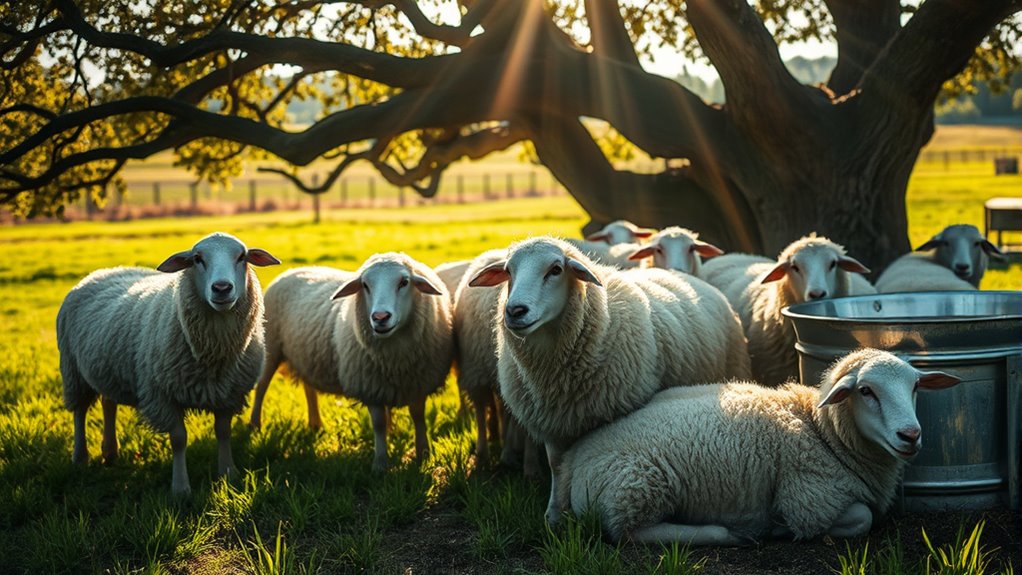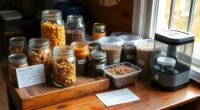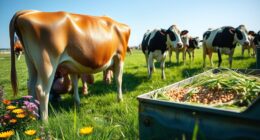If you notice rapid panting, open-mouth breathing, or excessive salivation in your sheep, they're likely stressed by heat. Factors like high temperatures, humidity, and fleece length can worsen their condition. To prevent this, ensure they have access to shade, clean water, and adjust feeding times. Monitor the Temperature Humidity Index to assess risk. With these strategies, you'll keep your flock healthier and more productive. There's more to discover about effective management and risk assessment.
Key Takeaways
- Monitor sheep for rapid panting, weakness, and refusal to lie down as signs of heat stress.
- Provide ample shade from trees or structures to help maintain a cooler environment.
- Ensure access to clean, cool water to keep sheep properly hydrated.
- Adjust feeding schedules to cooler times of the day, offering nutrient-dense diets.
- Utilize fans and misting systems to enhance cooling during extreme heat conditions.
Recognizing Signs of Heat Stress in Sheep
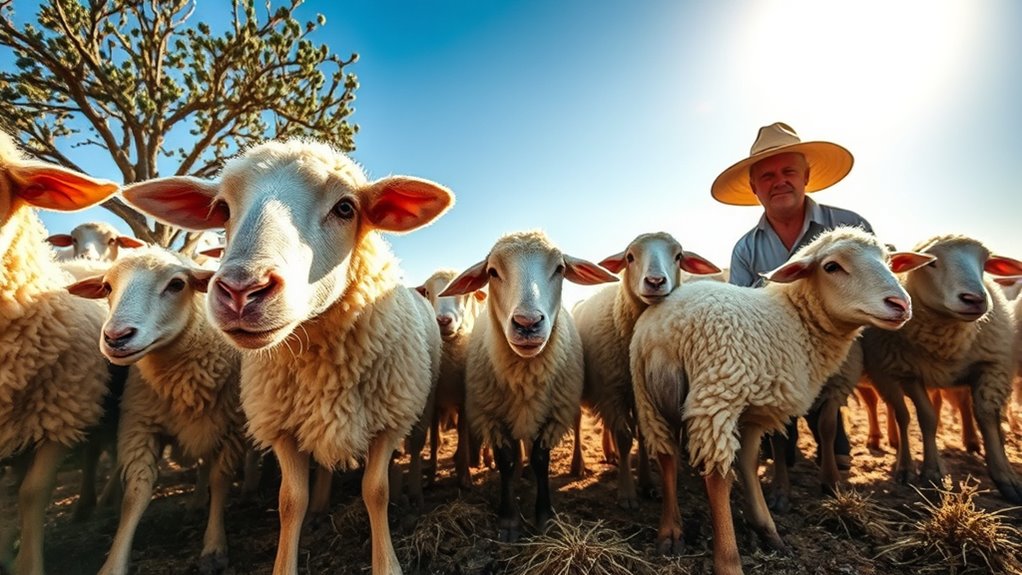
When you're caring for sheep, recognizing signs of heat stress is crucial for their well-being.
Look for respiratory changes like rapid panting, open-mouth breathing, and increased respiration rates. You might notice behavioral shifts, such as sheep seeking shade, crowding around water troughs, or standing for extended periods.
Physically, watch for excessive salivation, weakness, or elevated rectal temperatures above 41°C. Activity levels often decrease; they may refuse to lie down and seem lethargic.
Additionally, some sheep may wet their heads in water troughs or huddle together for shade. Regular observation can help you assess their condition, ensuring you take action before heat stress becomes severe.
Monitoring these signs keeps your flock healthy and thriving.
Factors Contributing to Heat Stress

Heat stress in sheep can arise from various factors that affect their ability to regulate body temperature. Climatic conditions such as high ambient temperatures, humidity, and direct solar radiation contribute significantly to heat gain.
Wind speed and night-time temperatures also play a role in heat dissipation. Animal characteristics, like fleece length and breed susceptibility, further influence heat stress levels, particularly in vulnerable lambs or pregnant ewes.
Environmental conditions, including lack of shade, poor ventilation, and overcrowding, can trap heat and moisture, exacerbating the situation.
Additionally, physiological responses like reduced feed intake and increased respiratory rates signal heat stress. Understanding these factors is crucial in managing your flock's well-being during hot weather.
Effective Management Strategies for Heat Stress
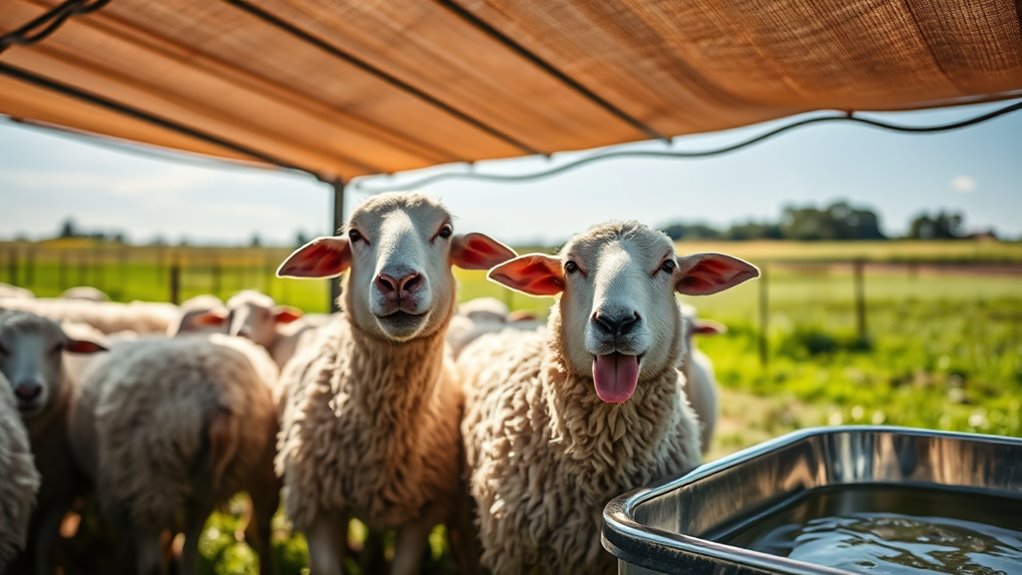
Managing heat stress in sheep requires proactive strategies that address the factors contributing to the issue. Start by providing adequate shade, whether from trees or man-made structures.
Implement cooling methods like fans and misting systems to help lower their body temperature. Ensure your sheep have access to clean, cool water for proper hydration.
Adjust feeding times to the cooler parts of the day and offer nutrient-dense diets to reduce metabolic heat production. Regularly monitor the Temperature Humidity Index (THI) to assess heat stress risk.
Consider rotational grazing and night grazing during extreme heat to keep your sheep cool. Lastly, keep an eye out for signs of heat stress to intervene early and protect your flock's health.
Preventive Measures to Mitigate Heat Stress
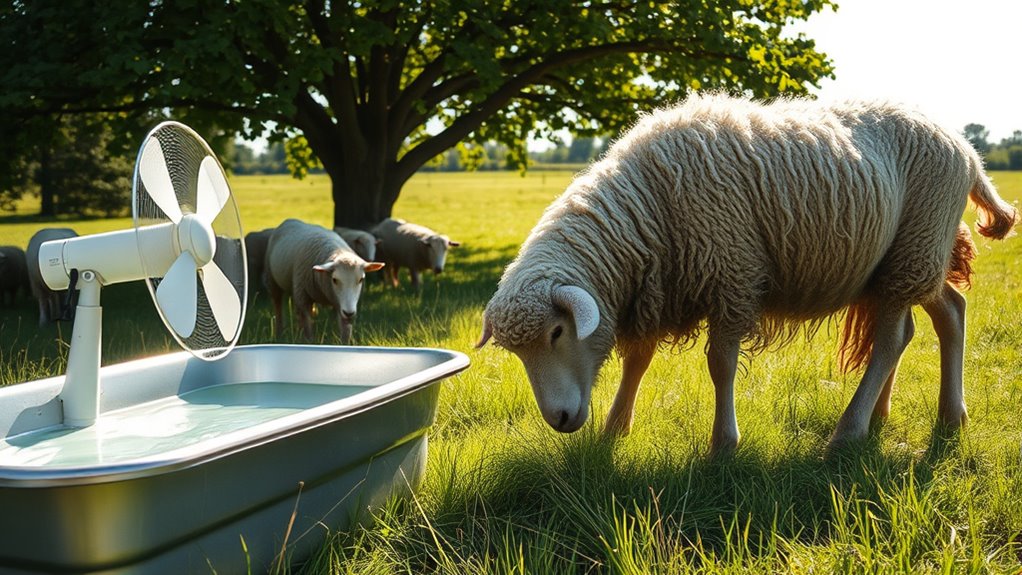
To effectively mitigate heat stress in your sheep, implementing a range of preventive measures is crucial.
First, ensure your flock has access to plenty of clean, cool water. Providing adequate shade through natural or artificial structures can significantly lower their body temperature.
Ensure your sheep have access to clean, cool water and adequate shade to help regulate their body temperature.
Adjust their diet to reduce metabolic heat production, and consider feeding during the cooler parts of the day. Selecting breeds with inherent heat tolerance will also help.
Utilize weather monitoring systems for early warnings and implement cooling systems like misting or sprinklers.
Lastly, ensure good ventilation in enclosed spaces and use shade structures like tarps or canvas.
These steps will create a more comfortable environment for your sheep, reducing the risk of heat stress.
Impact of Heat Stress on Sheep Production
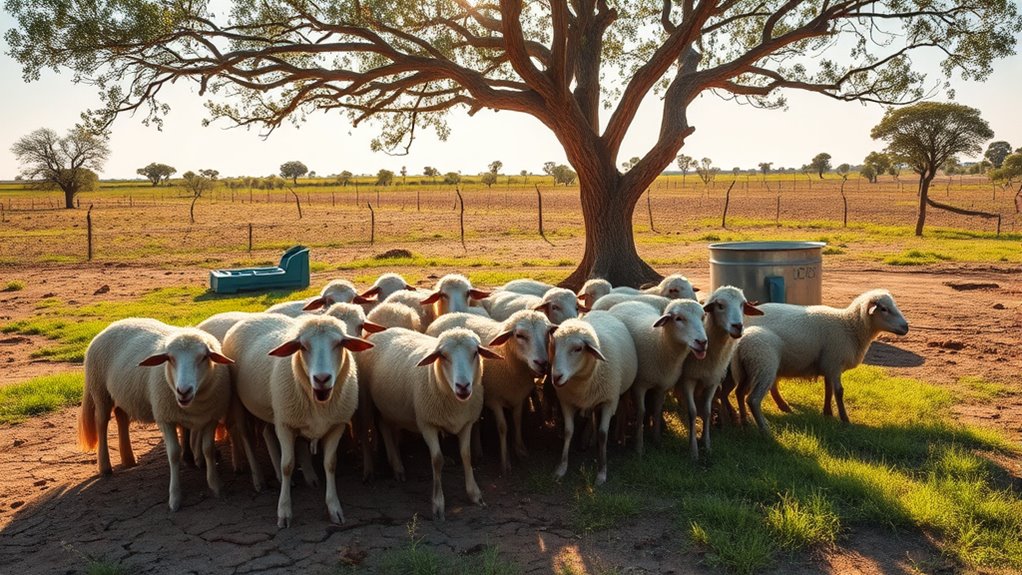
Implementing preventive measures can significantly reduce the risk of heat stress, but understanding its impact on sheep production is equally important.
Heat stress can lead to reduced fertility in ewes and rams, lowering conception rates and increasing embryonic mortality. Pregnant ewes facing high temperatures may see lamb birth weights drop by up to 1.4 kg, raising perinatal mortality risks.
Additionally, heat stress can cut milk yield by as much as 75%, while decreasing milk quality and increasing somatic cell counts. For meat production, it slows growth rates and reduces feed intake.
Wool production suffers too, with thinner, weaker fibers and shorter lengths. Ultimately, heat stress compromises sheep health, making them vulnerable to diseases and mortality.
Tools for Assessing Heat Stress Risk
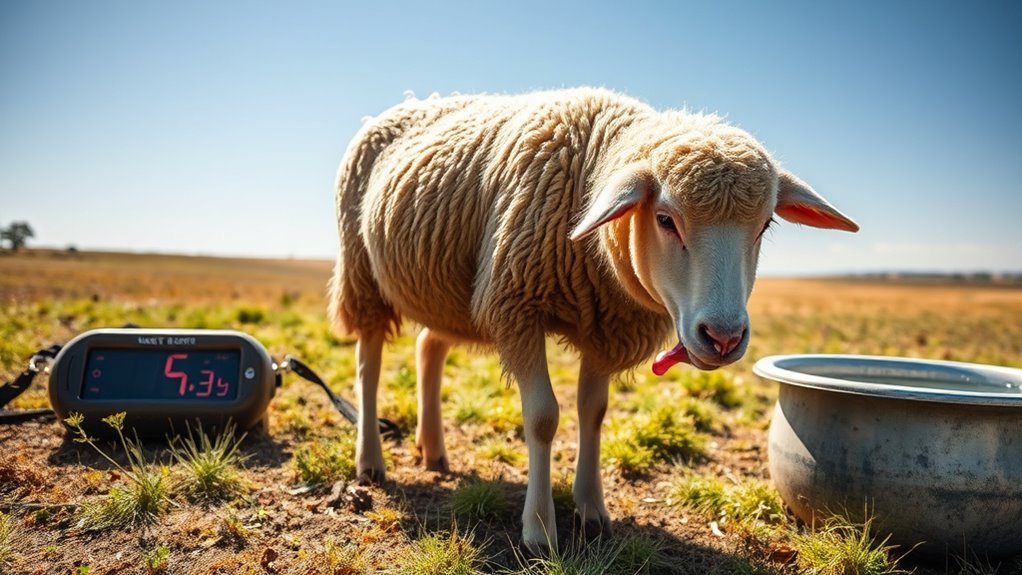
As temperatures rise and humidity levels fluctuate, recognizing the tools available for assessing heat stress risk in sheep becomes crucial for effective management.
The Temperature-Humidity Index (THI) and Comprehensive Climate Index (CCI) help you evaluate environmental stress levels. You can also leverage satellite-based monitoring for insights into pasture conditions.
Evaluate environmental stress levels in sheep using the Temperature-Humidity Index (THI) and Comprehensive Climate Index (CCI), along with satellite-based monitoring for pasture insights.
For real-time data, consider intra-ruminal boluses, thermal imaging, or wearable devices that track body temperature continuously.
Utilize livestock stress tools that provide forecasts based on weather station data. Decision support systems, like AI-driven advisory platforms, offer customized recommendations and alerts for high-risk conditions.
Frequently Asked Questions
How Can I Tell if My Sheep Are Suffering From Heat Stress?
You can tell if your sheep are suffering from heat stress by observing their behavior and physical signs.
Look for open-mouth breathing or panting, and notice if they seem lethargic or are crowding in shaded areas.
Reduced feed intake is another indicator, along with elevated body temperatures.
If you see them drinking more water or standing around instead of lying down, these are also signs they're struggling with the heat.
What Breeds of Sheep Are More Susceptible to Heat Stress?
If you're concerned about heat stress in sheep, be aware that certain breeds are more susceptible.
European breeds, wooled sheep, and those from cool climates struggle with heat due to their dense fleeces and body types. Short-legged breeds and dark-colored animals also absorb more heat, making them vulnerable.
Lambs, pregnant ewes, and sheep with poor nutrition are particularly at risk, so keep an eye on these factors when managing your flock.
Can Heat Stress Affect Sheep's Wool Quality?
Imagine a sheep standing in the sweltering sun, its wool becoming less vibrant and resilient.
Yes, heat stress can seriously affect your sheep's wool quality. High temperatures can shrink fiber diameter and weaken strength, much like a balloon losing air.
As humidity rises, wool production suffers further. If you don't manage heat stress effectively, you might notice a decline in wool growth and overall quality, impacting both aesthetics and economic value.
Are There Long-Term Effects of Heat Stress on Sheep?
Yes, there are long-term effects of heat stress on sheep.
You may notice decreased growth rates and lower reproductive success, impacting your flock's overall productivity.
Prolonged exposure can weaken their immune systems, making them prone to diseases.
Additionally, it can lead to metabolic disorders and reduced lifespan.
If you're not proactive, the long-term consequences can significantly affect the health and viability of your sheep over time.
What Should I Do if a Sheep Collapses From Heat Stress?
If a sheep collapses from heat stress, act quickly.
First, move it to a shaded area with good airflow. Apply cool water or rubbing alcohol to its bare skin, especially between the hind legs.
Offer fresh, cool water to help with hydration. Avoid drenching woolly areas, as it can trap heat.
If the sheep doesn't show improvement, contact your veterinarian immediately for further assistance.
Timely intervention is crucial for recovery.
Conclusion
In the sweltering heat, your sheep can feel like a fish out of water, struggling to cope. By recognizing signs of heat stress and implementing effective management strategies, you can help them thrive even on the hottest days. Just as a well-timed breeze can refresh a weary traveler, your preventive measures can keep your flock comfortable and productive. Remember, a little attention now can safeguard their health and your livelihood, ensuring a bountiful season ahead.

